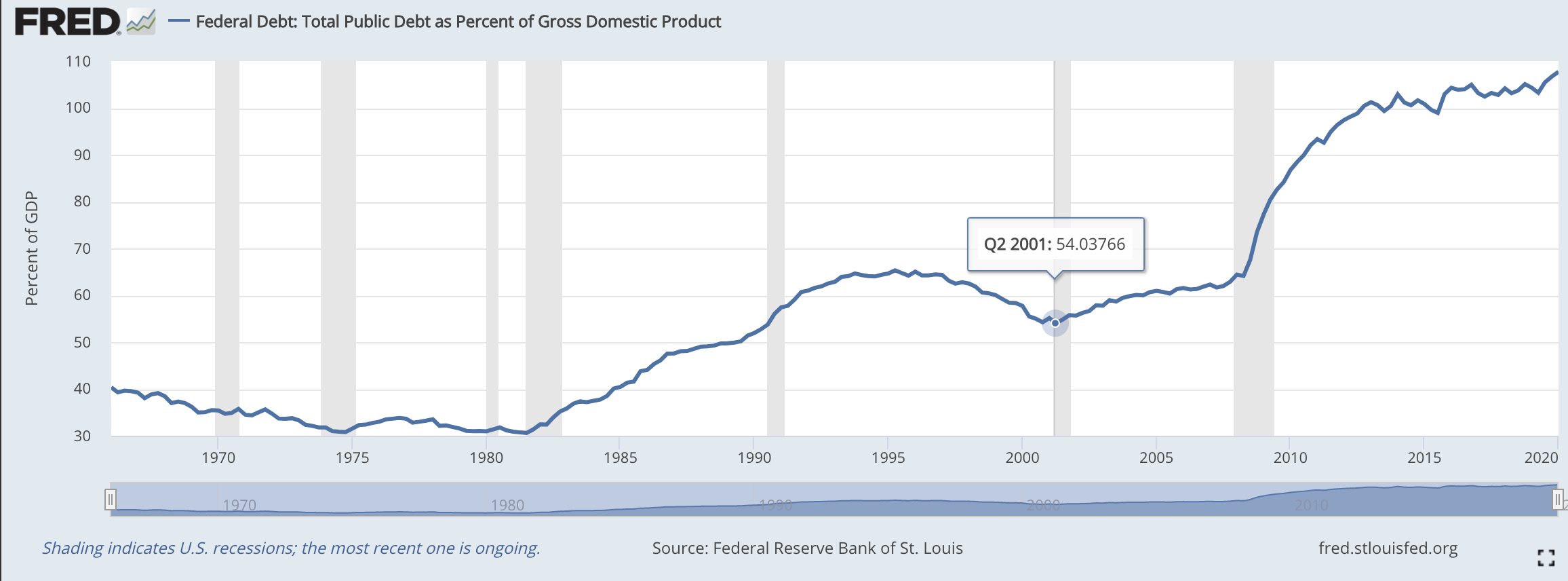1946年,时任美国总统哈里•杜鲁门面临衰退的经济状况和第二次世界大战的巨额账单。当时美国的债务水平为GDP的119%,这意味着其债务已经超过年度经济总产出。
由于庞大的联邦开支和新冠病毒造成的经济损失,美国今年的债务与GDP比率甚至高于这一数字。根据美国财务咨询网站The Balance的研究,这一比率到第三季度末将升至136%。
该数字令人担忧,因为债务所产生的利息最终可能会削减国家在其他地方的支出,比如医疗和国防等需要优先考虑的方面。
136%这一新高数字,反映出美国自1979年以来的债务增长趋势正在进一步加速,当时美国债务与GDP之比为31%。虽然债务水平在1995年至2005年之间有所下降,但圣路易斯联邦储备银行的数据显示,美国债务的总体趋势是稳步上升的。

美国当前的财政状况不禁让人发问,这个国家能否重现二战后的经济水平?当时由于经济快速增长,美国的债务水平迅速降低。
不幸的是,这种情况不太可能出现。大多数经济学家认为,美国现在很难达到上世纪50年代超过4%的平均增长率,原因在于国家的人口结构发生了变化。与战后时期相比,现在美国的人口年龄明显增大,这意味着年轻劳动力所占比例减少,而他们是推动经济发展的主体。
在经济没有强势增长的情况下,美国可能被迫削减开支,从而避免债务问题失控。
不过从短期来看,美国不太可能减少支出,因其希望国家和经济免遭新冠病毒破坏。一位专家在接受《华尔街日报》采访时,曾把如今的抗疫工作比作美国在二战中所面临的局面。
“战争的类比完全正确。我们过去和现在都在打仗。这次是病毒而非外国势力,不过消费水平不成问题。”美国经济顾问委员会前主席格伦•哈伯德对《华尔街日报》说道。(财富中文网)
译者:秦维奇
1946年,时任美国总统哈里•杜鲁门面临衰退的经济状况和第二次世界大战的巨额账单。当时美国的债务水平为GDP的119%,这意味着其债务已经超过年度经济总产出。
由于庞大的联邦开支和新冠病毒造成的经济损失,美国今年的债务与GDP比率甚至高于这一数字。根据美国财务咨询网站The Balance的研究,这一比率到第三季度末将升至136%。
该数字令人担忧,因为债务所产生的利息最终可能会削减国家在其他地方的支出,比如医疗和国防等需要优先考虑的方面。
136%这一新高数字,反映出美国自1979年以来的债务增长趋势正在进一步加速,当时美国债务与GDP之比为31%。虽然债务水平在1995年至2005年之间有所下降,但圣路易斯联邦储备银行的数据显示,美国债务的总体趋势是稳步上升的。
美国当前的财政状况不禁让人发问,这个国家能否重现二战后的经济水平?当时由于经济快速增长,美国的债务水平迅速降低。
不幸的是,这种情况不太可能出现。大多数经济学家认为,美国现在很难达到上世纪50年代超过4%的平均增长率,原因在于国家的人口结构发生了变化。与战后时期相比,现在美国的人口年龄明显增大,这意味着年轻劳动力所占比例减少,而他们是推动经济发展的主体。
在经济没有强势增长的情况下,美国可能被迫削减开支,从而避免债务问题失控。
不过从短期来看,美国不太可能减少支出,因其希望国家和经济免遭新冠病毒破坏。一位专家在接受《华尔街日报》采访时,曾把如今的抗疫工作比作美国在二战中所面临的局面。
“战争的类比完全正确。我们过去和现在都在打仗。这次是病毒而非外国势力,不过消费水平不成问题。”美国经济顾问委员会前主席格伦•哈伯德对《华尔街日报》说道。(财富中文网)
译者:秦维奇
In 1946, President Harry Truman confronted an economic downturn and a whopping bill for the Second World War. The country's debt level stood at 119% of GDP—meaning the U.S. owed more than its total annual economic output.
This year, as a result of massive federal spending and the economic toll of the coronavirus, the ratio of debt to GDP is even higher. According to research from The Balance, that ratio will reach 136% by the end of the third quarter.
The figure is a source of concern because interest payments on that debt could eventually crowd out other national priorities such as health or defense.
The new 136% figure reflects an acceleration of a trend that has been taking place since 1979 when the U.S. debt-to-GDP stood at 31%. While debt levels dipped between 1995 and 2005, figures from the St. Louis Federal Reserve show the overall trend has been steadily upwards:
The current fiscal situation raises the question of whether the U.S. economy will be able to replicate its performance of the years following World War II when debt levels shrunk rapidly thanks to rapid growth.
Unfortunately, that scenario is unlikely since most economists believe 1950s style growth rates, which averaged over 4%, are not achievable, in part because of the country's changed demographics. Compared to the post-war era, the U.S. population is significantly older, meaning there is a smaller share of younger workers to help drive the economy.
In the absence of strong growth, the U.S. will likely to have to rely on cutting spending in order to prevent its debt levels from becoming unmanageable.
In the short term, though, spending cuts are unlikely as the U.S. seeks to protect the country and the economy from the ravages of the coronavirus. In an interview with the Wall Street Journal, one expert likened the fight against COVID to what the U.S. faced during World War II.
“The war analogy is exactly the right one. We were and are fighting a war. It’s a virus, not a foreign power, but the level of spending isn’t the problem," Glenn Hubbard, a former chairman of the Council of Economic Advisers, told the Journal.






